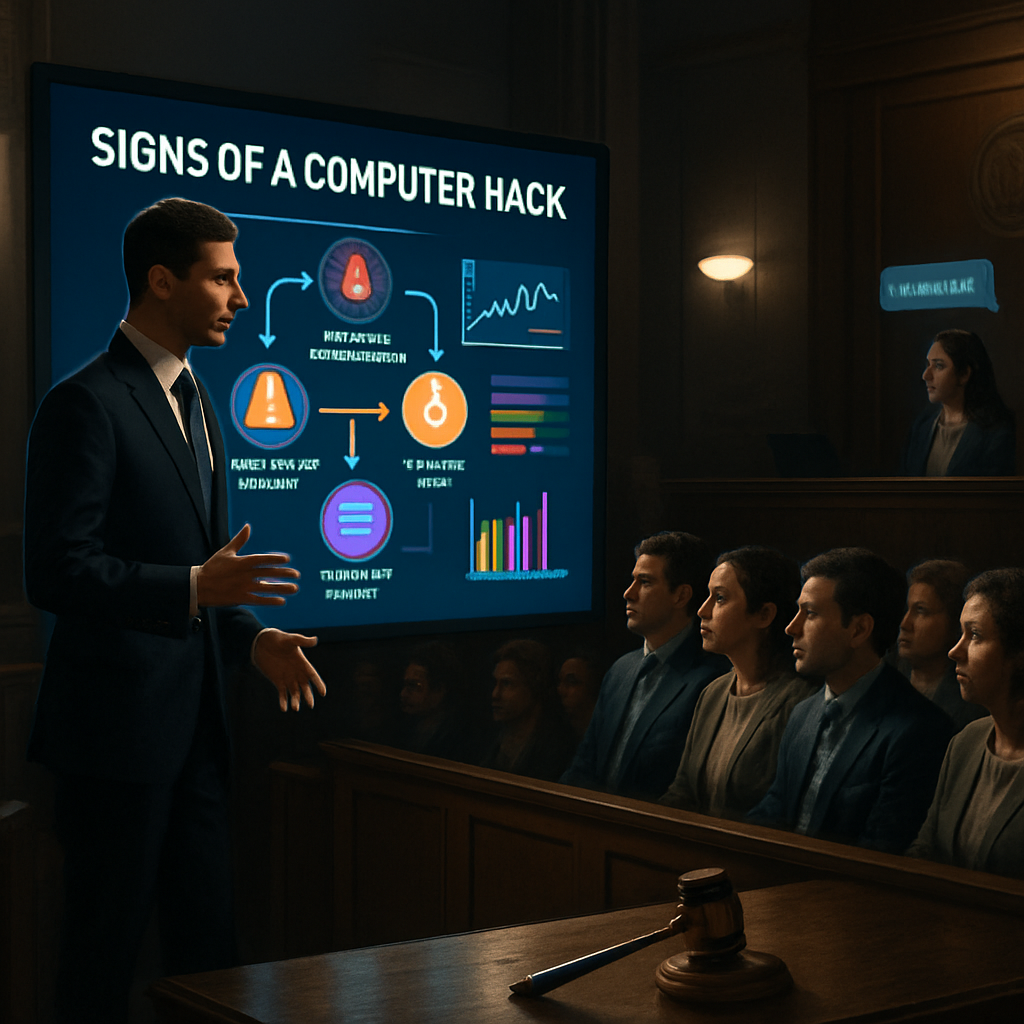Walk into a courtroom today and you’ll see the same rituals that have defined trials for centuries — lawyers pacing, witnesses testifying, jurors listening. But look closer and you’ll see something entirely new. Evidence once printed on paper or captured in photos has gone fully digital.
Server logs, text message threads, location data, financial transactions, cloud records — these are the new exhibits. And with them comes a new challenge: how to make digital complexity understandable and persuasive to human beings.
At Persuadius, we see this challenge in nearly every modern trial. The problem isn’t the lack of data — it’s the lack of story.
Digital evidence has changed the very texture of litigation. Instead of one incriminating email or photo, the truth often emerges from patterns — behavior over time, shifts in tone, data points aligning.
In other words, we’ve entered the age of the “smoking trendline.” The strongest evidence today rarely fits on a single page. It’s cumulative. It lives across devices and platforms, in timestamps and metadata.
That’s what makes it powerful — and perilous. When jurors face spreadsheets instead of photographs, they can quickly disengage. They may not grasp what matters, or they may overtrust data simply because it “looks official.” Either way, understanding breaks down.
Why Jurors Struggle with Digital Evidence
Most jurors are fluent in digital life — not digital systems. They know how to post, text, or shop online, but not how a database logs activity or what metadata reveals.
That familiarity without expertise creates what psychologists call a “false fluency effect.” Jurors feel confident because they recognize the format but misunderstand the substance.
This gap leads to predictable distortions:
-
Overconfidence: “The data speaks for itself.”
-
Skepticism: “Anyone can fake this.”
-
Fatigue: “I’m lost; I’ll just go with my gut.”
When digital evidence overwhelms, jurors unconsciously simplify — and in doing so, may miss the real story.
Trials are narratives in competition. If one side’s story dissolves in a sea of data, that side loses credibility — and often, the verdict.
When digital evidence is unclear:
-
Jurors rely on emotion instead of reasoning.
-
Critical patterns get lost.
-
Cases that should settle early drag on.
-
Trust in the process erodes.
But when data is organized into a coherent story — with clear visuals, pacing, and empathy — comprehension rises dramatically. The jury doesn’t just see information; they see why it matters.
The Persuasion Challenge: From Bytes to Belief
The real task isn’t to simplify data — it’s to translate it into human terms.
Persuasion science shows that comprehension depends on structure. Jurors don’t remember facts in isolation; they remember stories that organize those facts.
This is where the disciplines of trial graphics, storytelling, and cognitive psychology converge. The advocate’s role is no longer just to argue — it’s to design comprehension.
At Persuadius, we think of this as building narrative integrity: crafting a story that’s not only accurate but emotionally and logically coherent.
Step One: Build the Story Arc
Every data-heavy case needs a narrative spine — a structure with characters, conflict, and resolution.
Ask:
-
-
Who are the key players?
-
What conflict does the data reveal?
-
What turning points define the timeline?
-
How does the evidence explain “why” as well as “what”?
-
When jurors understand who did what and why it matters, data transforms from confusion to conviction.
Step Two: Visualize the Invisible
A spreadsheet is information. A timeline or trial graphic is understandable.
Visuals reduce cognitive load, making complex relationships instantly clear. Effective trial graphics don’t decorate — they distill.
Persuadius studies show that jurors process visual information up to 60,000 times faster than text. When they see behavior trends, message clusters, or sequences of events, they stop guessing and start grasping.
That’s why every high-stakes case deserves customized visuals that make patterns tangible — not generic charts, but persuasive stories in visual form.
🔗 Explore our Trial Graphics Book for examples of how great visuals change verdicts.
Step Three: Balance Emotion and Evidence
Data persuades the mind. Story persuades the heart. Winning requires both.
Modern jurors respond most strongly when technical information is anchored in human consequence — who was hurt, what was at stake, why it mattered.
This balance activates what neuroscientists call dual-coding pathways — verbal and visual memory working together. Studies show jurors remember information up to 22 times better when presented in both modes.
In the courtroom, that means pairing each key data point with a clear human takeaway. “What does this number mean for someone’s life?” is often the question that wins.
Step Four: Manage Cognitive Load
Jurors can only process so much before their attention collapses. That’s why structure and pacing matter as much as substance.
To manage cognitive load:
-
-
Present data chronologically, not thematically.
-
Use clean, minimalist visuals with limited on-screen text.
-
Group related evidence into “chapters” that feel self-contained.
-
Avoid jargon. Translate terms like “metadata” into metaphors jurors can grasp (“the file’s digital fingerprint”).
-
This isn’t dumbing down — it’s designing for comprehension.
Step Five: Engage Empathy
Facts convince, but empathy commits.
Research in persuasion shows that stories triggering empathy produce oxytocin, a neurochemical linked to trust and moral reasoning. When jurors empathize, they engage.
Show not only what happened but why it mattered to people. When jurors feel the impact, they listen differently — and they remember.
That’s why Persuadius emphasizes storytelling as emotional translation: connecting jurors to human experience through well-crafted visual and verbal design.
🔗 For more, download our free Storytelling Toolkit for Litigators.
Step Six: Practice Narrative Integrity
In complex data cases, credibility hinges on coherence. Jurors build “story models” as they listen — internal versions of events that must feel logical and complete.
If your story feels disjointed or inconsistent, even small data gaps become fatal. Conversely, a coherent story can withstand minor holes because it feels true.
Narrative integrity means every visual, fact, and testimony aligns toward one coherent explanation. It’s not just about truth — it’s about making truth easy to follow.
Bringing It All Together
The digital transformation of evidence isn’t slowing down — it’s accelerating. Every year brings new types of data, new devices, new sources.
But persuasion remains timeless. The principles that moved jurors in 1925 still move them in 2025: clarity, coherence, and credibility.
The difference now is that our medium has changed. Our job as litigators and consultants is to make that new medium human again — to turn bytes into belief, and data into decisions.
That’s what Persuadius does best: we bridge the gap between technical truth and human understanding.
The Path Forward
Litigators who master digital storytelling don’t just win more often — they make justice work better. When jurors understand, everyone benefits: cases resolve faster, settlements come earlier, verdicts are sounder, and trust in the process grows.
The takeaway is simple: the next generation of trial success will belong to those who can make the digital world persuasive.
If your next case depends on making data understandable — not just visible — let’s talk.
Schedule a consultation or send a confidential email to see how Persuadius can turn your evidence into a story that persuades.






Leave a Comment